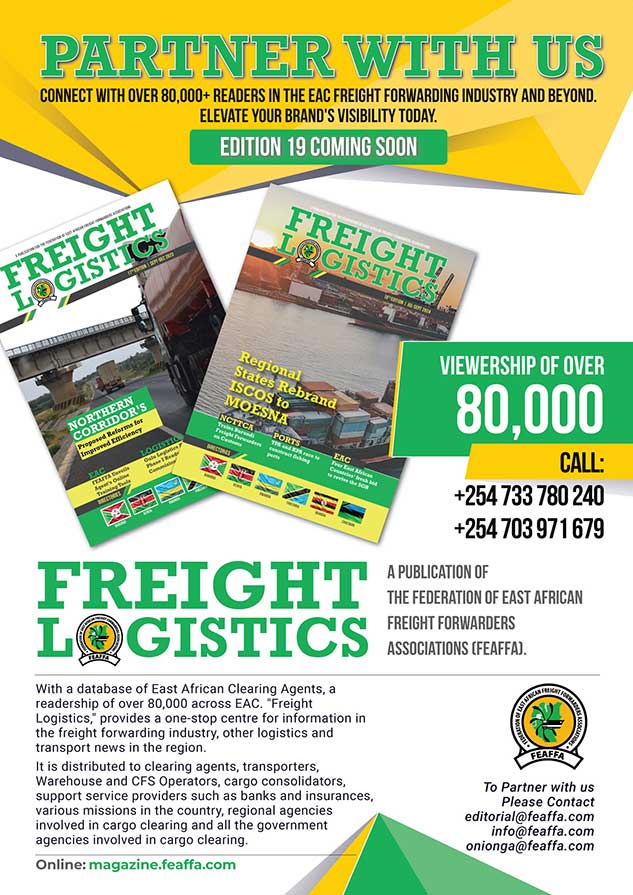The Kenya Railways (KR) has introduced a promotional tariff for its customers using the Madaraka Express Freight cargo services from Mombasa to Naivasha in a bid to attract more volumes in the wake of Covid -19 pandemic that has caused an economic slowdown across the business sector in the country and the East African region. This subsidized tariff will be in place for 90 days.
In the latest move to attract shippers to use the Inland Container Depot (ICD) from Mombasa to Naivasha, Kenya Railways has reduced freight charges from $600 to $480 for a 20-foot container and from $850 to $680 for a 40-foot container. The Corporation reiterated that the railway line offers a service that is premised on safety, efficiency and reliability.
“It is also convenient for East African partner states who will not have to cover an entire 572 kilometres between Mombasa and Naivasha. The Madaraka Express Freight Service train affords the customers the surety of delivering cargo on time and takes only 10 hours to transport cargo between Mombasa and Naivasha,” KR said in a statement.
In the past few weeks, a steady increase in cargo uptake by the Madaraka Express Freight Service has been witnessed, KR said further.
This is mainly because of sustained enactment of measures to streamline the processes in order to make the service more efficient by the key players in the freight transportation business via the SGR line mainly Kenya Railways, Kenya Ports Authority, Kenya Bureau of Standards and Kenya Revenue Authority, according to KR.
The pickup phase has witnessed over 30,000 tonnes transported between Mombasa and Naivasha in the past recent days.
The government started commercial cargo transport on SGR last month. The directive to have transit cargo to be transported and cleared through ICD Naivasha was rejected by Uganda authorities and Kenya industry players who pushed for willing buyer, willing seller, meaning that the KR had to embark on intense campaigns to lure cargo through the SGR.
KPA, which is the lead agency, has provided requisite office accommodation, for Revenue authorities in Uganda, Rwanda and South Sudan.
Last month, the Rwandan High Commissioner to Kenya Dr. Richard Masozera, Democratic Republic of Congo chargé d’affaires to Kenya Mr. Michel B. Muzare and Mr Lam Isaac from the Republic of South Sudan toured Naivasha ICD.
The facility has 45,000 Square Metres and has a capacity of handling 2 million tonnes of goods per year. It is meant to receive 216 Twenty Foot Equivalent Units (TEUs) every day at first.
The Naivasha ICD includes a one-stop centre for ease of operations and efficient service delivery. The port houses all the Government agencies involved in handling of cargo namely KR, Kenya Ports Authority, Kenya Revenue Authority, Kenya Bureau of Standards, Port Health (Public Health) and Revenue Authority officers from partner states of Uganda, Rwanda and Tanzania.
Mombasa port has in the recent years recorded a steady growth of the cargo volume. According to Kenya Ports Authority (KPA), the port handled over 34 million tonnes of throughput cargo by the close of 2019 compared with 28.550 million in 2018.
In Kenya, 70 per cent of cargo that pass through the port of Mombasa are for the local market with the rest going to east and central Africa.
In a move to encourage transit of the cargo through Naivasha, KPA extended storage period to 30 days. At the port, transit countries are allowed a free storage period of 9 days, which was extended to 15 days for a period of 90 days starting this month.
The Sh6.9 billion dry port facility commissioned by President Uhuru Kenyatta on December 17 last year cuts the distance between Mombasa and Kampala by 46 per cent.
Traditionally, Ugandan imports and exports travel a distance of 1,144 kilometers between Mombasa and Kampala along the Northern Corridor. SGR reduces the distance by about 527 kilometres.
Uganda is the biggest user of the Port of Mombasa among regional states, accounting for about 82 per cent of transit cargo to the hinterland through the Port of Mombasa.
Annual total transit traffic to the land-locked country stands at above 7.89 million tonnes, making it predominant transit destination through the Port of Mombasa.
Both Uganda and South Sudan have been given parcels of land by the government within the proximity of the Naivasha ICD. The parcels are ideal for cargo marshalling and other logistical investment.
Kenya International Freight and Warehouses Association (KIFWA) recent asked the government to make the cost of transporting containerized cargo from Mombasa to Naivasha competitive. When the Standard Gauge Railway (SGR) started transporting cargo to ICD in Embakasi, it applied a discounted tariff.
KIFWA also asked the government to encourage importers using ICD to use Through Bill of Lading, which identifies Naivasha depot as the landing point. These will save the importers from demurrage charges and also make it easy to ferry the empty containers to the shipping lines in Mombasa.
They also wanted importers to be allowed to choose the mode of transports between rail and road to Naivasha.





